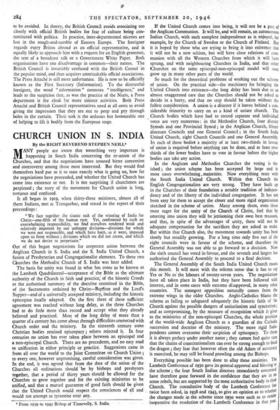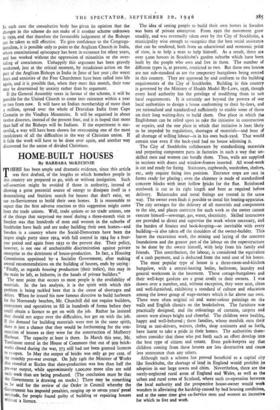CHURCH UNION IN S. INDIA
By the RIGHT REVEREND STEPHEN NEILL*
MANY people are aware that something very important is happening in South India concerning the re-union of the Churches, and that the negotiations have aroused bitter contention and controversy among those most interested. But they would find themselves hard put to it to state exactly what is going on, how far
the negotiations have proceeded, and whether the United Church has come into existence or not. It is not surprising if churchmen are perplexed ; the story of the movement for Church union is long, tortuous and confused.
It all began in 1919, when thirty-three ministers, almost all of them Indians, met at Tranquebar, and stated in the report of their proceedings: " We face together the titanic task of the winning of India for Christ—one-fifth of the human race. Yet, confronted by such an overwhelming responsibility, we find ourselves rendered weak and relatively impotent by our unhappy divisions—divisions for which we were not responsible, and which have been, as it were, imposed upon us from without ; divisions which we did not create, and which we do not desire to perpetuate."
Out of this began negotiations for corporate union between the Anglican Church in S. India and the S. India United Church, a fusion of Presbyterian and Congregationalist elements. To these two Churches the Methodist Church of S. India was later added.
The basis for unity was found in what has come to be known as the Lambeth Quadrilateral—acceptance of the Bible as the ultimate authority of the Church in faith and practice; of the historic Creeds as the authorised summary of the doctrine contained in the Bible, of the Sacraments ordained by Christ—Baptism and the Lord's Supper—and of a universally accepted ministry, including the historic episcopate locally adapted. On the first three of these sufficient agreement was reached without long delay, as the three Churches had to do little more than record and accept what they already believed and practised. Most of the long delay of more than a quarter of a century has come about through difficulties connected with Church order and the ministry_ In the sixteenth century some Christian bodies retained episcopacy ; others rejected it. In four centuries no union has ever taken place between an episcopal and a non-episcopal Church. There are no precedents, and no easy road to unification in either principle or practice. Suggestions came in from all over the world to the Joint Committee on Church Union ; to every one, however unpromising, careful consideration was given.
In the end, it was agreed that from the date of the union of the Churches all ordinations should be by bishops and presbyters together, that a period of thirty years should be allowed for the Churches to grow together and for the existing ministries to be
unified, and that a mutual guarantee of good faith should be given that the United Church would respect the consciences of all and would not attempt to tyrannise over any.
* From 1939 to 1945 Bishop of Tinnevelly, S. India. If the United Church comes into being, it will not be a part of the Anglican Communion. It will be, and will remain, an autonomous Indian Church, with such complete independence as is enjoyed, for example, by the Church of Sweden or the Church of Finland. But it is hoped by those who are trying to bring it into existence that it will not be a new schism, but will have close relations of com- munion with all the Western Churches from which it will have sprung, and with neighbouring Churches in India, and that other Churches on the same episcopal-non-episcopal model will soon grow up in many other parts of the world.
So much for the theoretical problems of working out the scheme of union. On the practical side—the machinery for bringing the United Church into existence—the long delay has been due to an almost exaggerated care that the Churches should not be asked to decide in a hurry, and that no step should be taken without the fullest consideration. A union is a disaster if it leaves behind a con- siderable minority to carry on as a kind of uniate church. The Church bodies which have had to record separate and individual votes are very numerous : in the Methodist Church, four district Synods and one Provincial Synod ; in the Anglican Church, fifteen diocesan Councils and one General Council ; in the South India
United Church, eight Church Councils and one General Assembly. In each of these bodies a majority of at least two-thirds in favour of union is required before anything can be done, and at least two- thirds of the lower bodies have to vote in favour before the higher bodies can take any action.
In the Anglican and Methodist Churches the voting is fin- ished ; the union scheme has been accepted by large and in most cases overwhelming, majorities. Now everything rests with the South India United Church. Within that Church the English Congregationalists are very strong. They have built up in the Churches of their foundation a notable tradition of indepen- dency and of the liberty of the individual congregation. It has not been easy for them to accept the closer and more rigid organisation sketched in the scheme of union. Many among them, even those most eager for the unity of the Church of Christ, feel that by entering into union they will be jettisoning their own best treasure, and that, in spite of the advantages of unity, there will not be adequate compensation for the sacrifices they are asked to make. But within that Church also, the movement towards unity has been slowly but steadily growing. For a long time only five out of the eight councils were in favour of the scheme, and therefore the General Assembly was not able to go forward to a decision. Now the sixth council has voted in favour, and the seventh and largest has authorised the General Assembly to proceed to a final decision.
The General Assembly of the South India United Church meets this month. It will meet with the solemn sense that it has to say Yes or No to' the labours of twenty-seven years. The negotiations have all taken place in India, but they have been followed with interest, and in some cases with extreme disapproval, in many other
countries. The strongest opposition naturally comes from the extreme wings in the older Churches. Angla-Catholics .blame the scheme as failing to safeguard adequately the historic faith of
Church against the possible dangers of unitarianism and syncretism; and as compromising, by the measure of recognition which it gives to the ministries of the non-episcopal Churches, the whole position
of the world-wide Anglican Church as a guardian of the Catholic succession and doctrine of the ministry. The more rigid Inde-
pendents cannot overcome their suspicion of episcopacy. To them it is always prelacy under another name ; they cannot feel quite sure that the chains of constitutionalism can ever be strong enough to bind the dragon ; they fear that however often the old Adam of autocracy is exorcised, he may still be found prowling among the Bishops.
Everything possible has been done to allay these anxieties. The Lambeth Conference of 1930 gave its general approval and blessing to the scheme ; the four South Indian dioceses immediately concerned have therefore gone forward in the confidence that they are in no sense rebels, but are supported by the most authoritative body in their Church. The consultative body of the Lambeth Conference has twice been asked, in 1938 and 1943, to give an opinion as to whether the changes made in the scheme since 1930 were such as to render inoperative the resolution of the. Lambeth Conference in that yea'.
In each case the consultative body has given its opinion that the changes in the scheme do not make of it another scheme unknown in 1930, and that therefore the favourable judgement of the Bishops can be taken as still effective. To give confidence to the Congrega- tionalists, it is possible only to point to the Anglican Church in India, where constitutional episcopacy has been in existence for many years, and has worked without the oppression of minorities or the over- riding of consciences. Unhappily this argument has been gravely weakened, just at the critical moment, by injudicious action on the part of the Anglican Bishops in India in June of last year ; the worst fears and anxieties of the Free Churchmen have been called into life again, and it is possible that, when they meet this month, their vote may be determined by anxiety rather than by argument.
If the General Assembly votes in favour of the scheme, it will be possible for the United Church to come into existence within a year or two from now. It will have an Indian membership of more than a million, spread over the whole of Dravidian India from Cape Comorin to the Vindhya Mountains. It will be organised in about twelve dioceses, instead of the present four, and it is hoped that more than half of the Bishops will be Indians. If the experiment is suc- cessful, a way will have been shown for overcoming one of the most recalcitrant of all the difficulties in the way of Christian union. If it fails the work will have to be done over again, and another way discovered for the union of divided Christians.



























 Previous page
Previous page